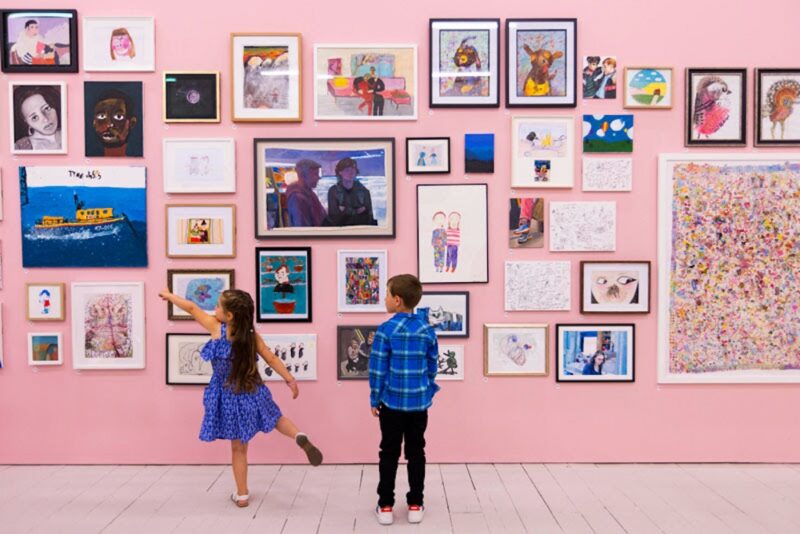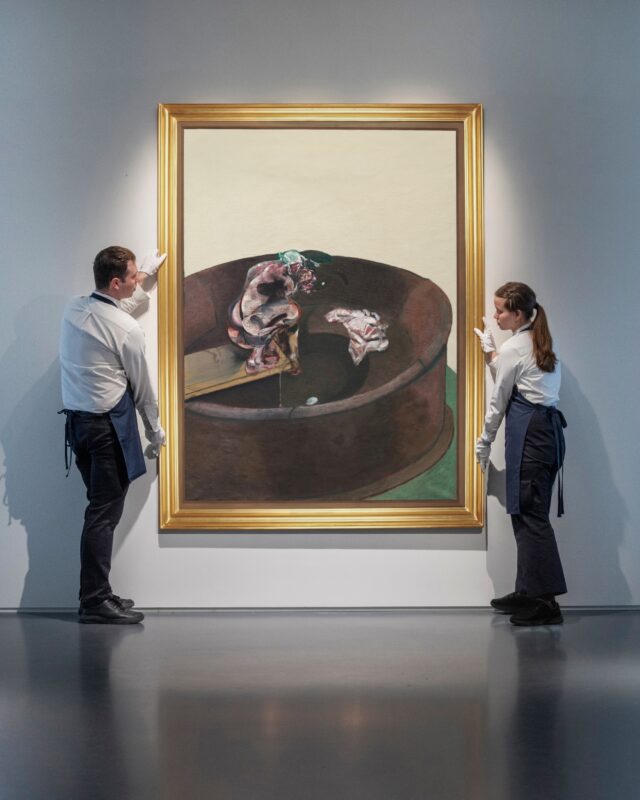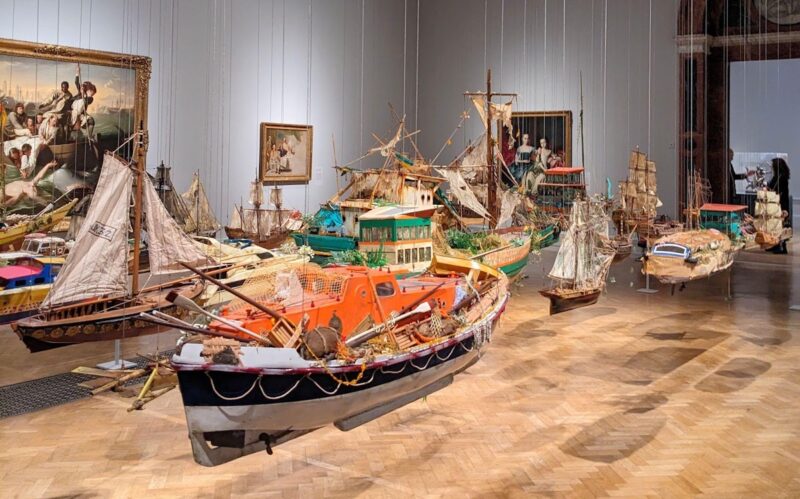For the first time in a decade, a major retrospective of paintings by 20th Century master Francis Bacon (1909-1992) is on display in London. A carefully curated selection of more than 40 paintings takes over the central galleries of the Royal Academy of Arts includes seminal triptychs and iconic artworks on loan from private collections including the Guggenheim Collection, Tate, the Musée du Beaux Arts de Lyon and the Sainsbury Centre for the Visual Arts. Bacon’s friend, art historian Dr. Michael Peppiatt, curated the exhibition with Sarah Lea and Anna Testar.
In the opening room of the exhibition hangs a monochrome painting of a figure that resembles a cross between a carcass in a butcher’s and a figure in the crucifixion pose. Titled ‘Crucifix’, this is the earliest work from Bacon’s career on display – painted in 1933 when the artist was only 24 – and it sets the tone for the haunting feeling of the exhibition. The walls of the RA have been painted in oppressive shades of oxblood and dark gray, lending a sobering feel to the overpowering nature of the paintings and their dark subject matter.

Francis Bacon (1909-1992) was renowned for his unsettling paintings of surreal, human-alien-animal hybrid forms, enclosed within imagined interiors. The exhibition’s curator Michael Peppiatt, who formed a friendship with Bacon during the 1970s and accompanied him on many louche evenings in the notorious Colony rooms and other Soho drinking dens, writes in the exhibition catalogue about the artist’s comparison of human beings to animals. He recounts a tale of an encounter in Soho one evening when he was out with Bacon and they came across a gang of youths attacking a body on the ground. Peppiatt says he was going to intervene when Bacon warned him: ‘You won’t come out of that. They’re animals. Worse than animals’, and later that evening he explained further: ‘Well, they were animals, real brutes, and behaving like animals. But then we are all animals if you care to think about it. It’s just that some of people are more aware of the fact than others. I think I’ve been very aware of it since I was a child. Perhaps it was something to do with the kind of introduction to life I had, being brought up with animals all around.’
And this insight into the upbringing and mindset of Bacon explains his fascination with animals and in exploring the more animalistic side of humans through his art.
‘Study for Chimpanzee’ (1957), features a human-like figure with the gnashing teeth of a chimpanzee, which was inspired by Bacon’s visits to London Zoo, and many of the paintings were inspired by Victorian photographer and anthropologist Eadweard Muybridge’s late 19th-century series of photographs of humans and animals in motion. ‘Head IV (Man with a Monkey), 1949, depicts a man in a formal suit peering into a void while the face of a monkey peers back at him, creating the effect of man and beast morphing into one another, and emphasising the lineage between humans and apes.
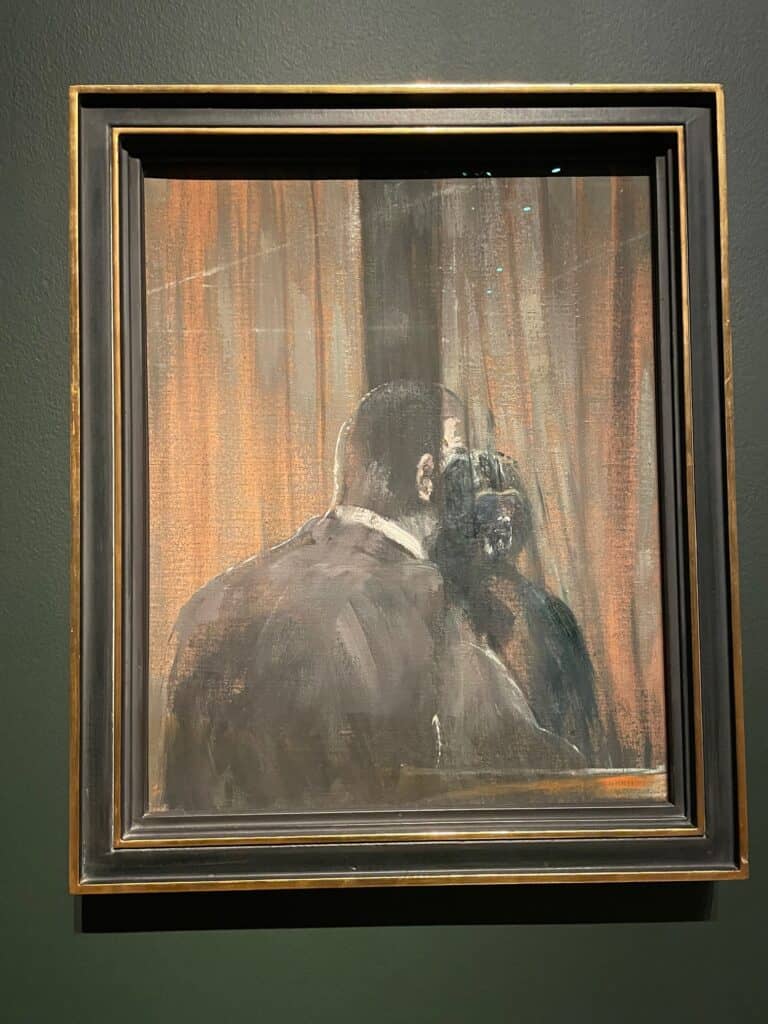
The source material for ‘Dog’ (1952), was Muybridge’s photographs of a mastiff walking. Bacon places his version of the mastiff inside a red hexagonal shape, with the impression of a seafront and formal gardens in the background, which resemble the view from Monte Carlo’s casino, which Bacon frequented during a period of living in Monte Carlo (1946-1950).
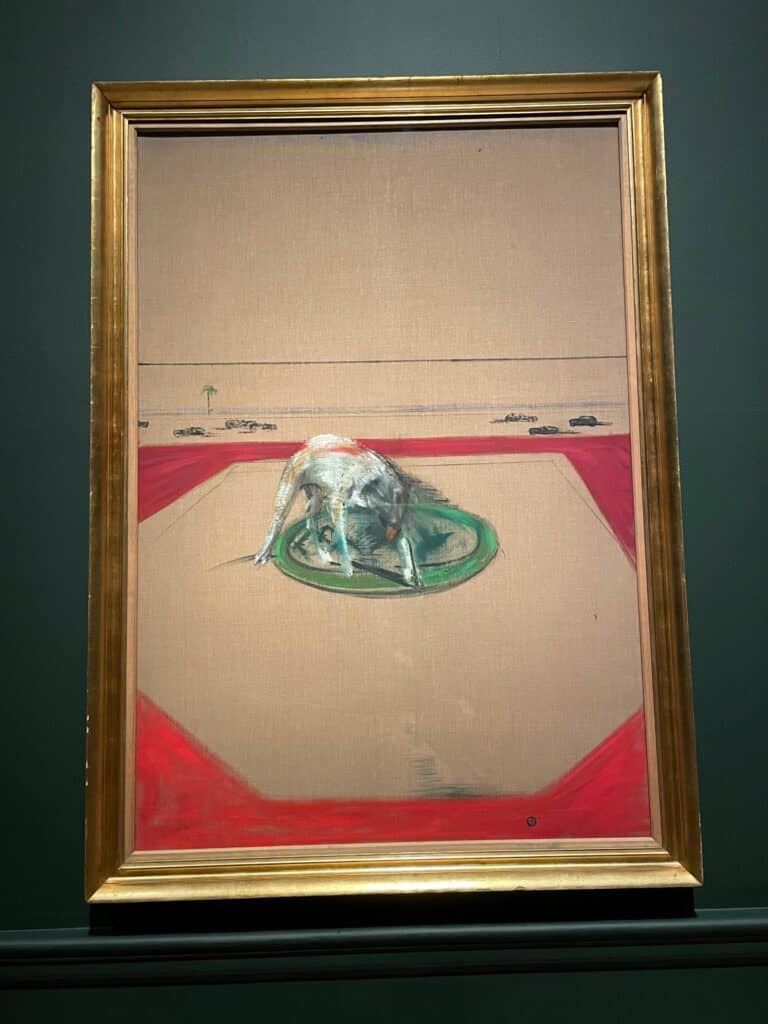
Bacon also collected wildlife books which inspired some of the paintings on display at the RA including ‘Owls’, 1956, and he studied the expressions and gestures of birds of prey, dogs, bulls and chimpanzees. By studying the unrestrained behaviour of animals, Bacon thought that he could gain a better understanding of the more feral side of humanity.
Other paintings in the exhibition depict the furies and reflects Bacon’s interest in mythology which emerged in his work. ‘Fury’ 1944 is exhibited in the RA exhibition and shows a biomorphic creature with a long silvery gray neck and distorted body, letting out a primal scream. Bacon described his furies as ‘organic form that relates to the human image but is a complete distortion of it’. The hybrid figures that populate some of the paintings are alien-like and inspired many a horror film – they bring to mind Ridley Scott’s 1979 dystopian space-horror ‘Alien’ or Dali and Buñuel’s 1929 Surrealist film ‘Un Chien Andalou’ (‘An Andalusian Dog’).
‘Second Version of Triptych 1944’ (1988), was a reworking of ‘Three Studies for Figures at the base of a Crucifixion, 1944’. The triptych features a central figure with a long grey neck and small round face dominated by blood-red lips and gnashing teeth, with a screaming fury-like figure in the right-hand triptych. The 1944 in the title of this violent, bloody triptych alludes to the suffering of so many during World War II, when close to 85 million people died before it ended in 1945. The intense pain portrayed in these images, and the animal-human-alien hybrid forms show the thin line between man and beast during the bloody battles of World War II. Bacon grew up during a time of world war, and the human capacity for extreme violence on a mass scale was reflected in his work.
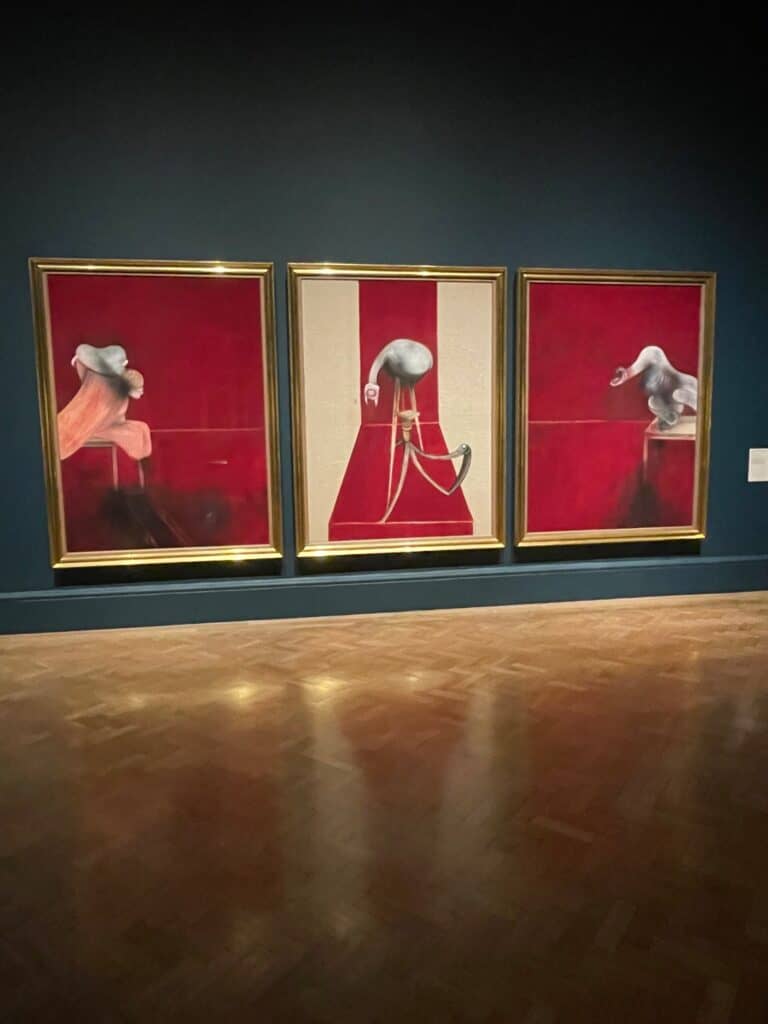
‘Man and Beast’ explores how Bacon’s fascination with animals informed and shaped his artistic subject matter: human beings and their innermost fears and desires. His interest in animals stemmed from a childhood spent growing up on a horse stud farm in Ireland with a father who often beat him and his siblings. At the age of 16, Bacon was banished from the family home by his conservative father who objected to his homosexuality at a time when it was illegal. After leaving home he spent time in Paris and Berlin before moving to London, where he found a set of like-minded people, becoming part of the liberal Soho nightlife scene. The trauma of those beatings and the observance of the life and death cycle of animals during a childhood on a stud farm, must have ignited in Bacon an interest in understanding the darker, more animalistic side of people.
Many of the images are unsettling and even disturbing, including the pope and referencing the inner animal inside human beings, and are often violent yet captivating with their visceral brushstrokes and kinetic sense of movement.
Bacon’s homosexuality is also a subject matter, and ‘Study for Portrait of P.L. No. 1’ (1957), shows his ex-lover Peter Lacey curled up on a sofa in a foetal-like position, perhaps in pain, alluding to their sadomasochistic relationship. ‘Two Figures in the Grass’ (1954) is a more romantic painting, depicting a same-sex couple in an intimate embrace, half submerged by long grass that evokes Bacon’s visits to South Africa. The painting was exhibited at the Institute of Contemporary Arts in London in 1955, 12 years before homosexuality was legalised in the UK, and provoked a complaint to the police by two upset women.

Perhaps the highlight is the display of three of Bacon’s bullfight paintings, which are united for the first time at the RA. Yet despite the beautiful portrayal of the magnificent bull, there is a dark side as there is to all Bacon’s paintings, as we see in the final gallery the bloody aftermath of a bull fight.

This isn’t an exhibition for the faint-hearted, and there is even an adult content warning before visitors enter the galleries. However, for art lovers this exhibition is a masterclass in how to depict the most primal instincts of humanity through art. Bacon was following in the footsteps of some of the most unforgettable war artists, such as Picasso, whose 1937 masterpiece ‘Guernica’ was painted in reaction to the Nazi bombing of the Basque town of Guernica during the Spanish Civil War, or Goya, whose ‘Los Desastres de la Guerra’(Disasters of War) series of prints recreated gory scenes from the Spanish-French Peninsular War of 1808–14 under Napoleon Bonaparte. These artists created images that serve as a powerful reminder of the inhumanity of warfare.
The exhibition opened at the RA during the same week as Holocaust Memorial day, which commemorated the death of six million Jews during the Nazi occupation of World War II, and just as the threat of Russia invading Ukraine in 2022 looms. Bacon’s visceral, provocative paintings depict the horrors of war, and act as a warning that we must not let history repeat itself by unleashing those animal instincts that can often lie too close to the surface. It’s difficult to look at the paintings, but difficult to look away.

